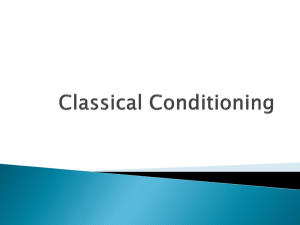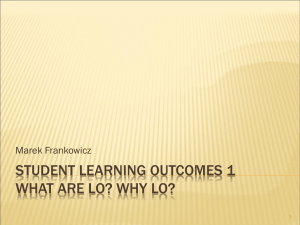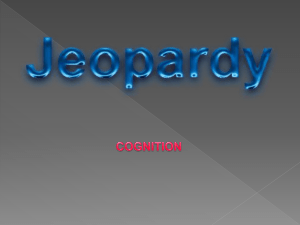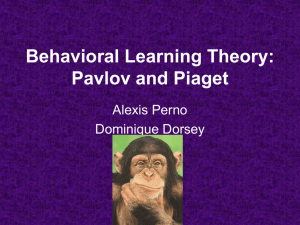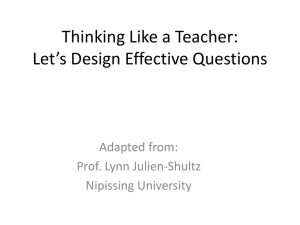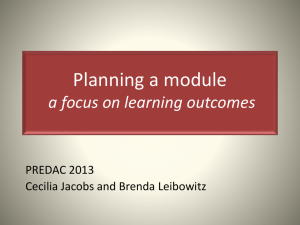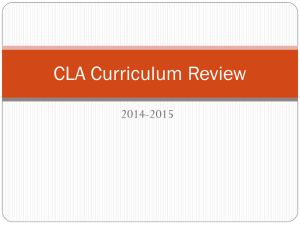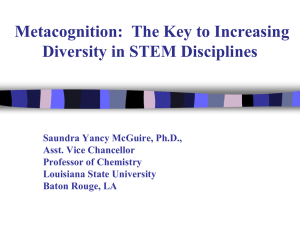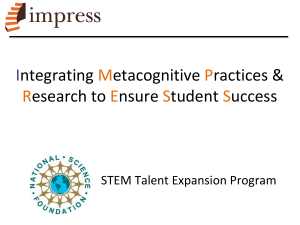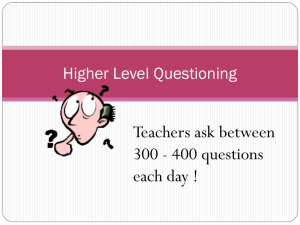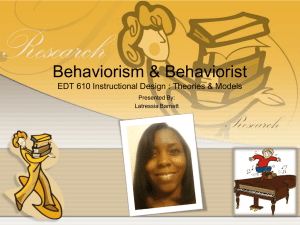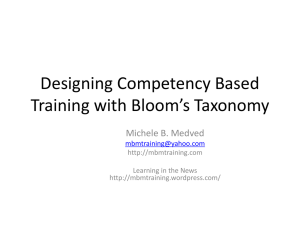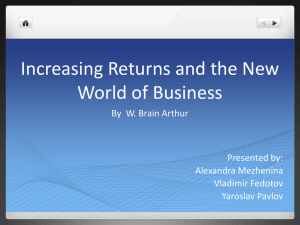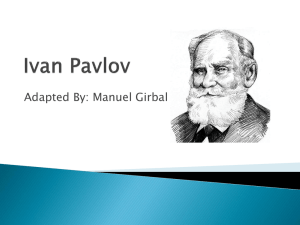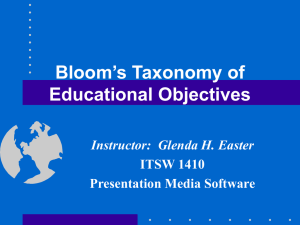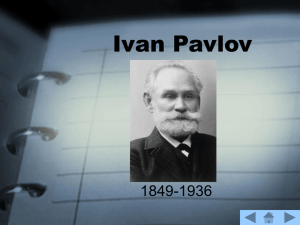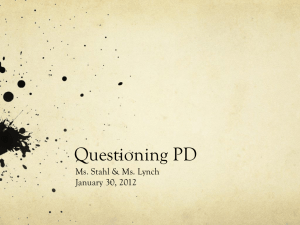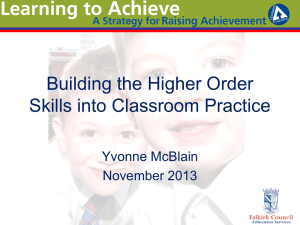Benjamin Bloom and the Taxonomy of Learning
advertisement
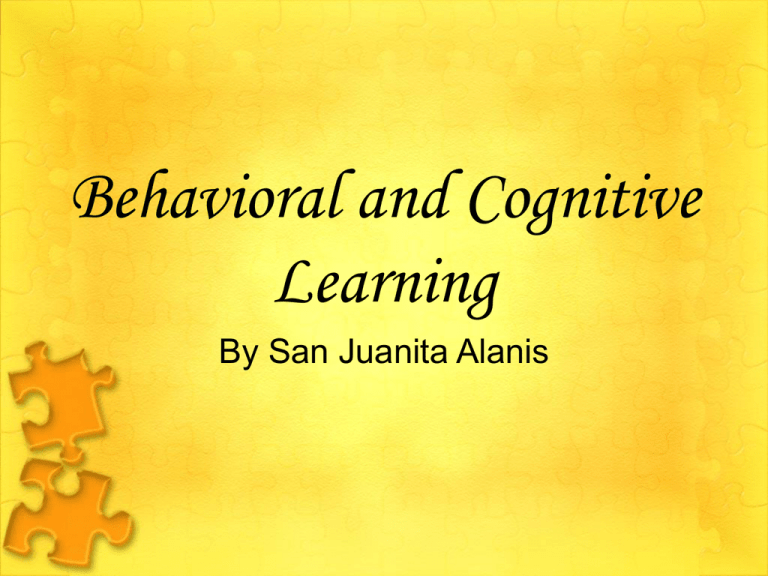
Behavioral and Cognitive Learning By San Juanita Alanis Introduction: Behaviorism and cognitivism are two different ways that people learn. Behaviorist believe that learning takes place when a change in behavior is the result of an experiment. Cognitivists believe that learning takes place when a change in mental representations and associations resulting from experience. This is why it is so important for an instructional designer to understand the different types of learning in order to meet the student’s needs. Cognitive Learning Benjamin Bloom • Benjamin Bloom was born on February 21, 1913 in Lansford Pennsylvania. • Died on September 13,1999 EDUCATION: • Benjamin Bloom received a Bachelor’s and a Master’s Degree from Pennsylvania State University in 1935. • And a Ph. D in Education from the University of Chicago in March 1942. • He then became an instructor in the Department of Education at the University of Chicago in 1944. What did he Accomplish? • He was appointed Charles H. Swift Distinguished Service Professor of Education at the University of Chicago at Hyde Park. • At this university he founded and chaired the program in Measurement, Evaluation and Statistical Analysis (MESA). • Founding member of IEA (1958). • Initiator of the IEA Pilot Study (1960) and First International Mathematics Study (1964). • Consultant on evaluation and curriculum to nations throughout the world. • Past President of the American Educational Research Association (AERA). Member of the United States National Academy of Education. • Author and co-author of 17 major books. The three types of learning are: • Cognitive: mental skills (Knowledge) • Affective: growth in feelings or emotional areas (Attitude) • Psychomotor: manual or physical skills (Skills) His major theory was that you can not understand a concept if you do not first remember it, similarly you can not apply knowledge and concepts if you do not understand them. • In 1950 he developed the chart on cognitive objectives. The six levels of learning are: 1. Knowledge: the ability to recall or recognize information, ideas, and principles in the approximate form in which they were learned. 2. Comprehension: the translation, comprehension, or interpretation of information based on prior learning. 3. Application: the selection, transfer, and use of data and principles to complete a problem or task with a minimum of direction. Continue the Six levels of Learning 4. Analysis: distinguishing, classifying, and relating the assumptions, hypothesis, evidence, or structure of a statement or question. 5. Synthesis: the origination, integration, and combination of ideas into a product, plan, or proposal that is new to the individual. 6. Evaluation: an appraisal, assessment, or critique developed on the basis or specific standards and/or criteria (Huitt, 2004). In the 1990's, a former student of Bloom, Lorin Anderson, revised Bloom's Taxonomy and published this- Bloom's Revised Taxonomy in 2001. The key to this is the use of verbs rather than nouns for each of the categories and a rearrangement of the sequence within the taxonomy. They are arranged below in increasing order, from low to high. • • • • • • Here is Bloom’s Revised Taxonomy. Remembering - Recognising, listing, describing, identifying, retrieving, naming, locating, finding Understanding - Interpreting, Summarizing, inferring, paraphrasing, classifying, comparing, explaining, exemplifying Applying - Implementing, carrying out, using, executing Analyzing - Comparing, organizing, deconstructing, Attributing, outlining, finding, structuring, integrating Evaluating - Checking, hypothesizing, critiquing, Experimenting, judging, testing, Detecting, Monitoring Creating - designing, constructing, planning, producing, inventing, devising, making The vital elements of mastery learning are: 1. Clearly specifying what is to be learned and how it will be evaluated; 2. Allowing students to learn at their own pace; 3. Assessing student progress and also providing appropriate feedback or remediation; 4. Testing that final learning criterions have been achieved. Behaviorist Ivan Pavlov • • • • • • • According to Mindy Lautenheiser “Ivan Petrovich Pavlov was born on September 14, 1849, at Ryazan, Russia. Pavlov died in Leningrad on February 27, 1936. EDUCATION 1870: Leaving his religious career, Pavlov enrolled to take a natural science course at the University of St. Petersburg. 1875: Graduated from the University of St. Petersburg and took an assistantship from Cyon in his laboratory at the Military-Medical Academy; received the degree of Candidate of Natural Sciences Summer of 1877 : He spent time in Physiological Laboratory of Professor R. Heidenhain at Breslau 1879: Graduated from the Military-Medical Academy 1879: Completed third course of study at the Academy of Medical Surgery; awarded his first gold medal. Major Theories Pavlov began experiments with dogs that proved their reflexes could be conditioned by external stimuli. He would condition the dogs by the ringing of a bell at feeding time. These dogs would salivate upon hearing the bell, whether or not food was present. This is what he called Classical Conditioning. Important Terms • Unconditioned stimulus (UCS) - stimulus that causes a natural response. • Unconditioned response (UCR) - natural inbuilt reflex to a stimulus. • Conditioned stimulus (CS) - a stimulus that causes a natural learned response due to association with a previous inbuilt response. • Conditioned response (CR) - a natural learned reflex to a stimulus due to association with another inbuilt response. Classical Conditioning • Pavlov conducted, perhaps, the most famous of all psychological experiments (1927) when he showed that by pairing a conditioned stimulus (a bell) with an unconditioned stimulus (food), a dog would begin to salivate (response) when the bell was rung without presenting the food Conclusion People learn in different ways. As we have seen by the two different theorists that I chose it is very important for an instructional designer to understand the different types of learning in order for effective learning to take place. References ATHERTON J S (2009) Learning and Teaching; Bloom's taxonomy [On-line] UK: Available: http://www.learningandteaching.info/learning/bloomtax.htm Accessed: 4 October 2009. Bloom Benjamin. Benjamin Bloom and the Taxonomy of Learning. 2002-2009. http://oaks.nvg.org/taxonomy-bloom.html Accessed 4 October 2009. Pavlov Ivan. Nobel Lectures. Physiology or Medicine 1901-1921. Elsevier Publishing Company. Amsterdam. 1967. http://nobelprize.org/nobel_prizes/medicine/laureates/1904/pavlov-bio.html Accessed 4 October 2009.

